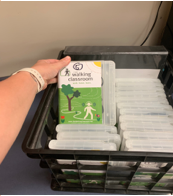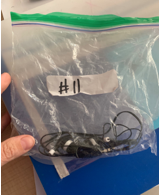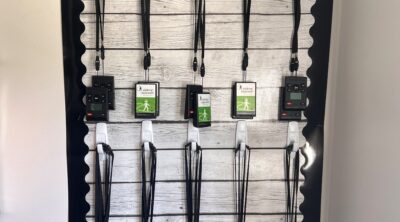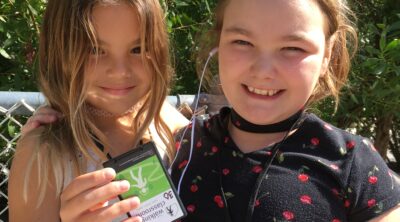This post is the third in this year’s Walk This Way series, designed to share The Walking Classroom experiences of teachers and students across the United States. It provides a glimpse into Caitlin Watson’s class.
A new school year is upon us (or already here for some of us!). Ready to get this amazing program moving in your classroom? I am here to give you some “get started” tips that have worked for us in our school.
Setting Up and Storing Program Materials
 At my school, two teachers and I share a class set of WalkKits, so we’ve had to be creative with how we store and share them! We’ve taken all the walk-its in their cases, labeled the cases with numbers from 1 to 25, and put them in order in a milk crate. All of our kids have a number assigned to them in their classroom, so they just take the WalkKit that corresponds with their number.
At my school, two teachers and I share a class set of WalkKits, so we’ve had to be creative with how we store and share them! We’ve taken all the walk-its in their cases, labeled the cases with numbers from 1 to 25, and put them in order in a milk crate. All of our kids have a number assigned to them in their classroom, so they just take the WalkKit that corresponds with their number.
 At the beginning of the week, the other teachers and I discuss when and what time we plan on using the WalkKits, and we pick up the milk crate from whoever had it last. Students have a baggie with their number on it that they keep in their desk with a set of headphones. When it’s time to go, they get their walk-it, grab their headphones, and we’re ready to walk!!
At the beginning of the week, the other teachers and I discuss when and what time we plan on using the WalkKits, and we pick up the milk crate from whoever had it last. Students have a baggie with their number on it that they keep in their desk with a set of headphones. When it’s time to go, they get their walk-it, grab their headphones, and we’re ready to walk!!
A Route that Works for You!
When picking an outdoor route, there are a couple of things you should keep in mind:
 Length. The podcasts are about 15 minutes long, but can vary. You will want to pick a path you can shorten or lengthen, depending on the time limit. Maybe find a five-minute loop you can do two or three times. That way, if the podcast’s a little shorter, you can just skip a loop, or if it’s a little longer, you can add a loop. We head out our front door and walk the bus loop three to five times.
Length. The podcasts are about 15 minutes long, but can vary. You will want to pick a path you can shorten or lengthen, depending on the time limit. Maybe find a five-minute loop you can do two or three times. That way, if the podcast’s a little shorter, you can just skip a loop, or if it’s a little longer, you can add a loop. We head out our front door and walk the bus loop three to five times.
Availability. Is the place you are picking always available? Last year I found this beautiful grassy loop that was PERFECT. What I didn’t realize is that sometimes the grass would be long, sometimes the grass was being cut, and sometimes the fifth graders were practicing kickball! So while it was perfect in concept, it wasn’t in practice. Try to think of ALL the possibilities for things to go wrong in the spaces at your school and pick the one with the most availability.
How About Rainy Days?
When picking an indoor or “rainy day” route, consider the following:
 Transition Traffic. Think about transition times. For example, if you are going to be looping through the kindergarten hallway, make sure you aren’t walking through when they are transitioning to lunch or fine arts. It will be very hard for your students to walk and concentrate when you are “swimming upstream”!
Transition Traffic. Think about transition times. For example, if you are going to be looping through the kindergarten hallway, make sure you aren’t walking through when they are transitioning to lunch or fine arts. It will be very hard for your students to walk and concentrate when you are “swimming upstream”!
Distractions. Set your students up for success. Remind them that they need to focus extra hard inside of school because there are a lot more distractions. Have a discussion about what to do if someone tries to walk up to them, or if you run into a traffic jam. Make sure there is a procedure for every problem you may encounter, because when you fail to plan, you plan to fail!
Where to Find the Time
We fit in our Walking Classroom time in several different ways.
To replace a normal class period. Pick a podcast that goes with your “I can” statement that day. Use the comprehension quiz as an activity or make up an activity to go with it!
During recess time. On days we have PE, we aren’t required to do recess, so we will do walking classroom instead. As morning work that day, I give the students the comprehension quiz as a pre-test. Then, after our walk, I have them come back and revise their answers. I usually use this approach to reinforce, enhance, or front load a concept I am teaching in class.
On PDD’s and half days. This is a great way to give your students something fun, interesting and standards-based on these days that sometimes feel like a waste!
I hope that these tips help you in getting your Walking Classroom journey started, and happy new school year! May your meetings be short, your planning periods be long, and may your coffee always be warm.
Happy Trails!
Caitlin Watson
Fourth Grade Teacher
Diamond View Elementary






Leave a Reply